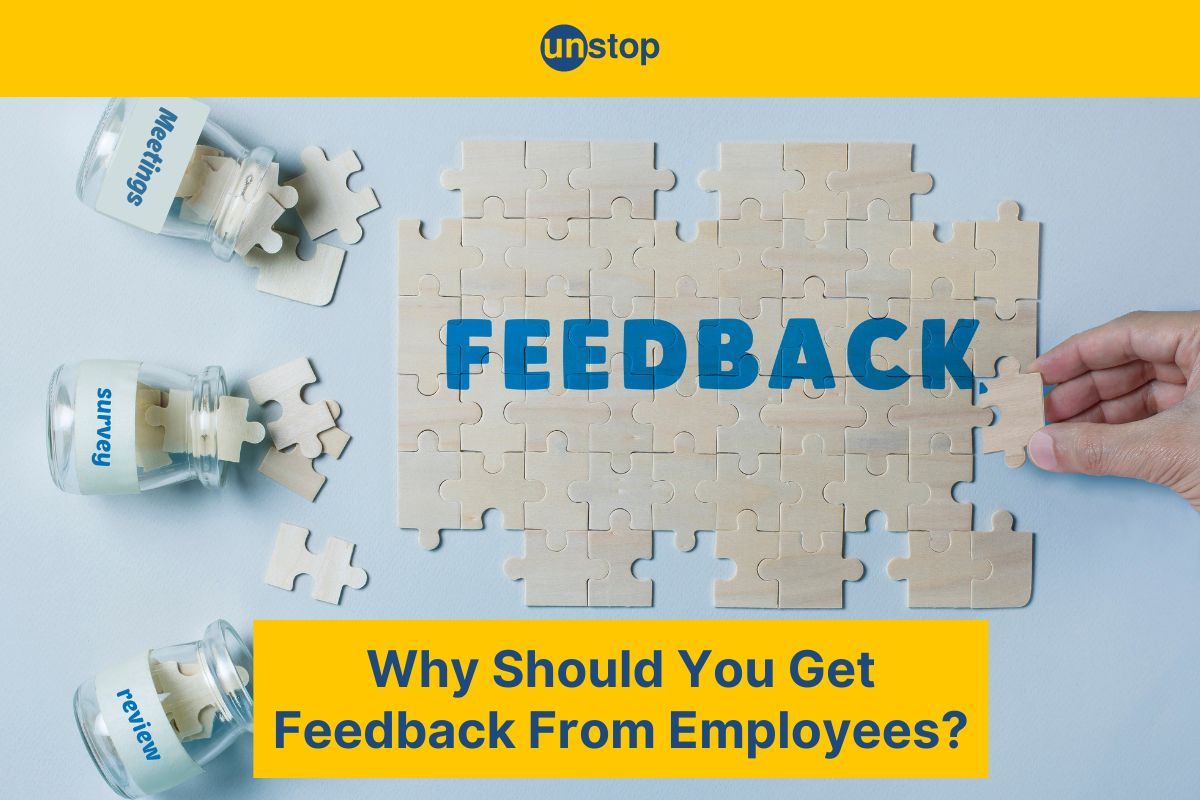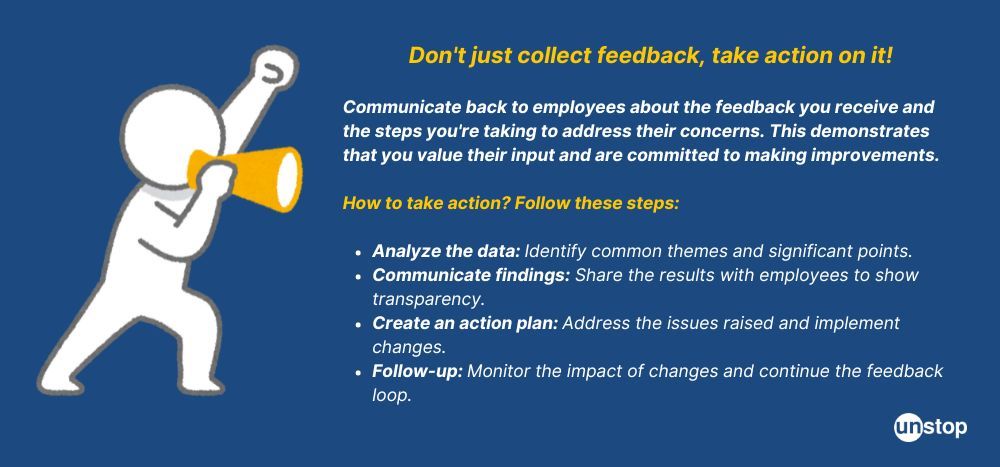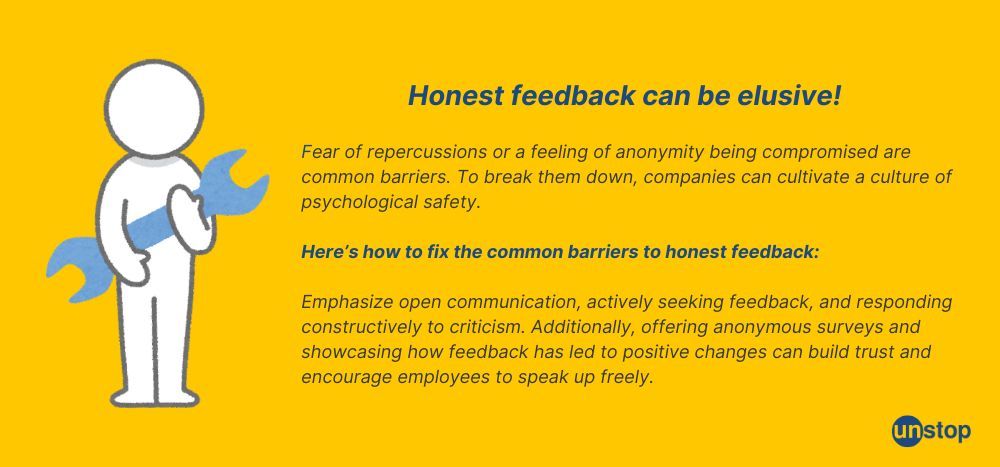- Importance Of Employee Feedback
- Methods To Collect Honest Feedback
- Choosing The Right Feedback Method
- Barriers To Collecting Feedback From Employees
- Creating A Feedback-Positive Culture
- Closing Thoughts
- Frequently Asked Questions
How To Get Feedback From Employees: Importance, Challenges & Methods

Ever felt like you're flying blind when it comes to employee satisfaction?
Recruiters and HR professionals, we've all been there. We craft compelling job descriptions, curate a stellar candidate experience, and enthusiastially onboard new talent. But after the initial honeymoon phase, how can we be sure we're fostering a thriving work environment?
The answer lies in a readily available powerful tool: employee feedback.
In this article, we'll understand why we need to get feedback from employees and explore the different methods that can supercharge your recruitment and retention strategies. Ready to unlock the full potential of your organization? Dive in!
Importance Of Employee Feedback
Empowerment and Engagement
Employee feedback plays a crucial role in organizational growth by empowering employees to voice their opinions and concerns. When employees feel heard and valued, their satisfaction and engagement levels increase significantly. This, in turn, leads to higher productivity and employee satisfaction.
Communication, Trust, and Collaboration
Feedback acts as a catalyst for enhancing communication, trust, and collaboration within teams. Regular feedback sessions during team meetings promote open dialogue, transparency, and constructive discussions. As a result, relationships between managers and employees, as well as among team members themselves, strengthen, leading to better teamwork and overall success.

Methods To Collect Honest Feedback
Pulse Surveys
Pulse surveys are quick, frequent surveys that provide valuable insights into employee sentiments and engagement levels. These surveys typically consist of a few key questions aimed at capturing real-time feedback.
Implementing pulse surveys allows organizations to promptly address any emerging issues, leading to improved employee satisfaction and retention rates. Moreover, the anonymity of these surveys encourages employees to share their honest opinions without fear of repercussions.
One-on-One Meetings
Conducting regular one-on-one meetings with employees fosters open dialogue and strengthens the employer-employee relationship. These meetings provide a platform for employees to express their thoughts, concerns, and suggestions in a more personal setting.
One-on-one meetings offer a deeper understanding of individual perspectives and allow for tailored feedback discussions. This approach cultivates a sense of trust and transparency within the organization, enhancing overall communication effectiveness.
Anonymous Feedback Channels
Utilizing anonymous feedback channels such as suggestion boxes or digital platforms ensures that employees can share their feedback without revealing their identities. This anonymity promotes candid responses and enables employees to voice their concerns freely.
Suggestion boxes are great for gathering genuine feedback about office premises and policies. Utilize online employee feedback tools that allow employees to submit feedback anonymously or publicly. These platforms can offer features for easy data collection, analysis, and response management.
Open-Door Policy
Foster an open-door policy where employees feel comfortable approaching managers or HR with any concerns or suggestions. This demonstrates your commitment to open communication and feedback.
Stay Interviews
Proactive stay interviews with high performers can help identify potential roadblocks to their satisfaction and retention. This allows you to address concerns and take steps to keep your top talent engaged.
Stay interviews delve into the reasons why employees choose to remain with a company, allowing employees to express their needs, concerns, and aspirations.
Focus Groups
Organize focus groups on specific topics to gather in-depth feedback from a smaller group of employees. This can be helpful for delving deeper into specific issues or areas for improvement.
The key advantage of using focus groups to get feedback from employees is that they allow for in-depth discussions and insights from a diverse group of individuals, leading to a more comprehensive understanding of employee perspectives and experiences.

Choosing The Right Feedback Method
Here are the key factors to consider when choosing the right method to get feedback from employees:
1. Purpose of the Feedback
- What information are you trying to gather? Are you looking for general employee sentiment, specific feedback on a new policy, or in-depth insights on a particular project?
- Action or Information: Do you need actionable feedback to address issues or simply informational feedback to understand employee perspectives?
2. Target Audience
- Number of Employees: Are you seeking feedback from a small team, a specific department, or the entire organization?
- Employee Preferences: Consider your employees' preferred preferred communication styles. Some might prefer anonymity, while others might be comfortable with open discussions.
3. Impact of Feedback
-
Positive vs. Negative: Different feedback methods impact employee engagement differently. Regular check-ins, like weekly progress updates, foster continuous improvement and communication. On the contrary, annual performance reviews may feel disconnected from daily work realities, leading to disengaged employees.
4. Desired Level of Anonymity
- Transparency and Honesty: Do you need complete anonymity to encourage honest feedback, or is some level of identification acceptable?
- Subject Sensitivity: Is the feedback likely to be sensitive or controversial? Sensitive topics might require a more private approach.
5. Implementation Ease
- Time Commitment: How much time can you dedicate to collecting and analyzing feedback? Some methods require more time investment than others. Face-to-face conversations require scheduling and coordination but offer immediate interaction and clarity. Digital platforms, such as feedback tools or email surveys, are convenient to distribute and collect responses quickly.
- Available Resources: Consider the resources available, such as budget for online tools or staff time for conducting surveys or interviews.
- Scalability: Feedback methods vary in scalability, ranging from one-on-one meetings to anonymous surveys. One-on-one discussions allow for personalized feedback but may be time-consuming in large organizations. Anonymous surveys, on the other hand, can reach a wider audience but might lack depth in responses.
Additional Considerations
- Company Culture: Choose a method that aligns with your company's communication style and level of formality.
- Technology & Tools: Explore online feedback tools that integrate with your existing systems and are user-friendly for employees.
- Timing of Gathering Feedback: Regularly, but not so frequently that it becomes burdensome. Quarterly surveys, annual reviews, and periodic one-on-one meetings are common practices.
Choosing the Right Method to Get Feedback from Employees
Here's a quick guide to some popular methods and when they might be most suitable:
| Method | Suitability |
|---|---|
| One-on-One Meetings | Ideal for in-depth feedback discussions, providing specific guidance, and addressing sensitive topics. |
| Anonymous Surveys | Great for gathering honest feedback on sensitive topics or employee sentiment across a large group. |
| Pulse Surveys | Useful for gathering frequent, short-form feedback on specific topics or to gauge overall morale. |
| Focus Groups | Effective for in-depth exploration of specific topics with a smaller group of employees who can share different perspectives. |
| Open-Door Policy | Encourages ongoing communication and allows employees to raise concerns or suggestions at their convenience. |
| Stay Interviews | Provides valuable insights from high-performing employees to understand reasons for their staying and challenges, if any. |
Remember: The most effective feedback methods are combined to create a comprehensive system for gathering employee input. By considering these factors and choosing the right methods, you can encourage open communication, improve employee engagement, and make data-driven decisions to create a better workplace.
Barriers To Collecting Feedback From Employees
To get feedback from employees that is authentic and actionable, it’s important to look out for common barriers, like the following:
- Fear of retaliation: Employees may be afraid to provide honest feedback if they fear negative consequences such as being passed over for promotions or even losing their job.
- Lack of trust: Employees may not trust that their feedback will be kept confidential or that it will actually lead to positive change within the organization.
- Time constraints: Employees may feel they do not have the time to provide feedback, especially if they are already overwhelmed with their workload.
- Communication barriers: Language barriers, lack of access to technology, or even physical distance can make it difficult for employees to provide feedback easily.
- Ineffective feedback mechanisms: Employees may be less likely to participate if the feedback process is too complicated or not user-friendly. For example, if a company only allows feedback to be given in person during a busy workday, employees may not feel comfortable or have the time to provide their thoughts.

Creating A Feedback-Positive Culture
Transparency
Promoting transparency within the organization fosters trust and encourages open communication among team members. By sharing information openly, employees feel valued and respected.
Safe Space
It is crucial to create a safe space for employees to express their thoughts without fear of judgment or reprisal. It allows individuals to contribute ideas freely, leading to innovation and creativity.
Role Modeling
Leaders play a pivotal role in shaping a feedback-positive culture by demonstrating active listening and constructive feedback practices. When the leadership team embraces feedback, it sets a precedent for others to follow suit.
Closing Thoughts
Now that you understand the significance of employee feedback, the various types available, and how to foster a culture that embraces it, you are equipped to collect honest feedback effectively. By selecting the right method tailored to your organization's needs, you can harness the power of employee feedback to drive positive change and growth within your company.
Remember, feedback is a valuable tool for improvement and should be embraced at all levels of your organization. Your employees' voices matter—listen to them.
Frequently Asked Questions
1. What is the importance of employee feedback?
Employee feedback is crucial for improving morale, productivity, and overall company performance. It fosters a culture of open communication, boosts employee engagement, and helps in identifying areas for growth and development.
2. What are some methods to collect honest feedback from employees?
Methods to collect honest feedback include anonymous surveys, focus groups, one-on-one meetings with managers or HR representatives, suggestion boxes, online platforms for submitting feedback, and regular check-ins to discuss concerns or suggestions openly.
3. How can a company create a feedback-positive culture?
To create a feedback-positive culture, companies should encourage open communication, provide regular opportunities for feedback, train managers on giving constructive feedback, recognize and act upon the received feedback, and foster a safe environment for sharing opinions.
4. How can a company choose the right method for collecting employee feedback?
Companies should consider factors like the size of the organization, the nature of the work environment (remote or office-based), preferences of employees regarding anonymity or direct communication, existing communication channels within the company, and the desired depth of insights when selecting an appropriate feedback collection method.
5. What are some common barriers to getting honest feedback from employees?
- Fear of retaliation: Worry about negative consequences.
- Lack of trust: Doubt that feedback will be taken seriously or used positively.
- Poor communication channels: Inadequate methods for providing feedback.
- Perceived futility: Belief that nothing will change regardless of feedback.
Suggested Reads:
- Assessing Problem-Solving Skills in Job Candidates
- Personality Assessments For Hiring: Effective Strategy And Benefits
- Beyond First Impressions - Deflecting The Halo And Horn Effect In Hiring
- Multi-Measure Assessments Can Improve Hiring Results. Here's How
- Coding Test Strategies For Hiring: 10+ Tips For Success
I’m a reader first and a writer second, constantly diving into the world of content. If I’m not writing or reading, I like watching movies and dreaming of a life by the beach.
Login to continue reading
And access exclusive content, personalized recommendations, and career-boosting opportunities.
Subscribe
to our newsletter
Blogs you need to hog!

Organize Hackathons: The Ultimate Playbook With Past Case Studies

What is Campus Recruitment? How To Tap The Untapped Talent?

Lateral Hiring: A Complete Guide To The Process, Its Benefits, Challenges & Best Practices













Comments
Add comment